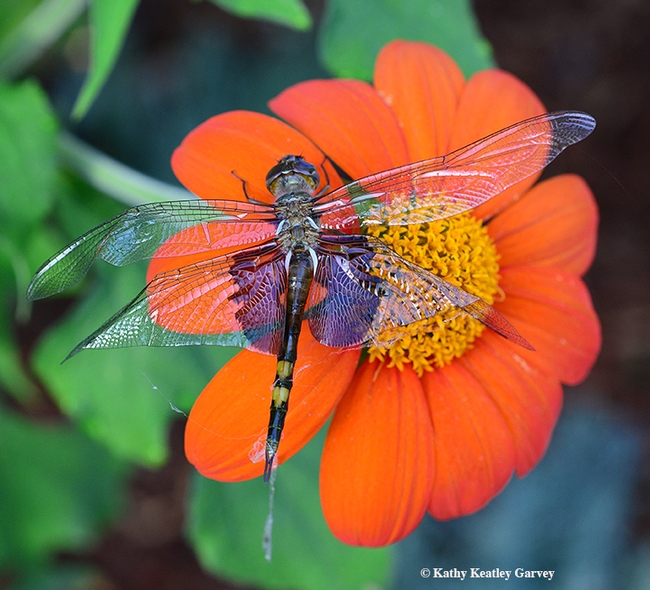It's always a good day when you encounter a dragonfly on Main Street USA.
Such was the case on Wednesday, July 17 when seemingly out of nowhere, a shiny Tramea lacerata "black saddlebags" appeared in front of me on the sidewalk fronting the Vacaville Chamber of Commerce.
Its habitat is near ponds, lakes, ditches, slow streams, or other bodies of water, but there it was.
"It is a freshly emerged female, probably on its maiden flight," said naturalist Greg Kareofelas of Davis, an associate with the Bohart Museum of Entomology, University of California, Davis. "This is its most vulnerable time. If it gets through the next day or so, off to fast flying it will go and you will never get close to it again."
I gingerly picked it up and photographed it on a Mexican sunflower (Tithonia). Half an hour later, I witnessed it fly over our fish pond, never to be seen again. At least by me!
This species, found throughout North America, is included in a Bohart Museum's poster, "Dragonflies of California." Designed by Fran Keller (then a doctoral student in entomology at UC Davis and now an assistant professor at Folsom Lake College), with images by Kareofelas, the poster is available in the Bohart Museum's gift shop in Room 1124 of the Academic Surge Building on Crocker Lane, UC Davis campus.
The black saddlebags dragonfly belongs to the Order Odonata (dragonflies and damselflies), suborder Anisoptera (dragonflies) family Libellulidae (skimmers), genus Tramea (saddlebags) and species lacerata (black saddlebags). "It flies constantly, often gliding, perches infrequently," according to BugGuide.net. The University of Michigan biokids website yields more information.
It's easily distinguishable. Says Wikipedia: "It has distinctive wings with characteristic black blotches" at its proximal ends, "which make the dragonfly look as though it is wearing saddlebags. The black saddlebags is a relatively large dragonfly at about 5 centimeters in length. The body is thin and black, and the female may have lighter spotting or mottling dorsally. The head is much wider than the rest of the body and is dark brown in color...Some populations of this dragonfly undertake migrations. Both the larvae and adult forms are efficient predators of mosquitoes so they are a helpful insect to have in wet areas where mosquito infestations occur." A wonderful predator...
Of predators, sidewalks and black saddlebags...
Attached Images:
